Project Management Report: Construction of Fuel Storage Facility in WA
VerifiedAdded on 2021/04/17
|10
|1987
|114
Report
AI Summary
This project management report details the construction of a fuel storage facility in Western Australia. The report outlines the project's goals, including renovating oil tanker storage and improving site access. It analyzes the project scope, defining in-scope and out-of-scope items, and describes the process for determining the project scope. Key stakeholders, such as the steering committee, managerial level, and operational department, are identified along with their importance to the project. The key deliverables, including the oil storage facility, project plan, and documentation, are specified, alongside the project's acceptance criteria. The report then provides an overview of the project life cycle using the waterfall model, detailing monitoring and controlling processes. Finally, the report defines the success criteria, including time, quality, and cost, for the project's successful completion. The report references various project management resources and methodologies.
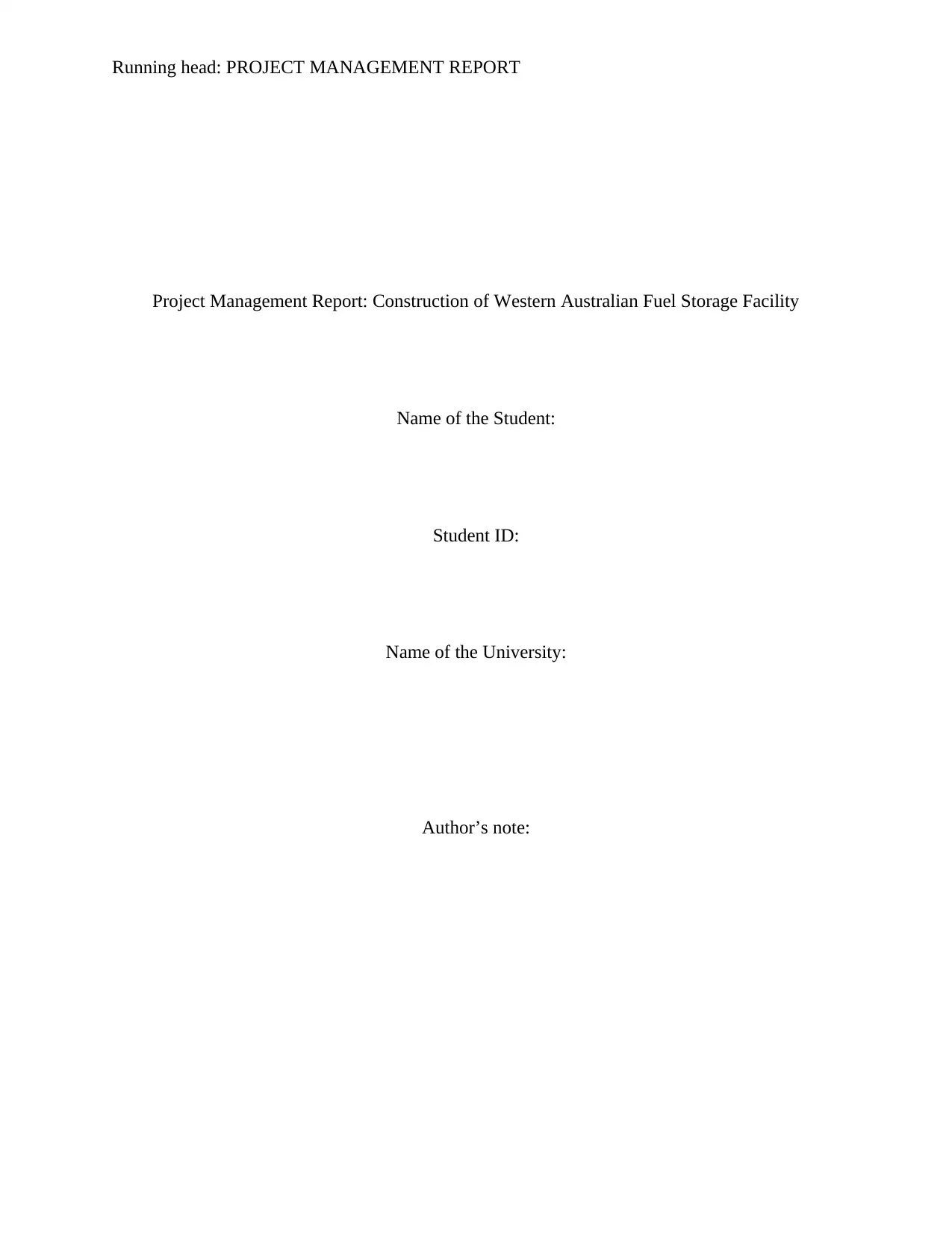
Running head: PROJECT MANAGEMENT REPORT
Project Management Report: Construction of Western Australian Fuel Storage Facility
Name of the Student:
Student ID:
Name of the University:
Author’s note:
Project Management Report: Construction of Western Australian Fuel Storage Facility
Name of the Student:
Student ID:
Name of the University:
Author’s note:
Paraphrase This Document
Need a fresh take? Get an instant paraphrase of this document with our AI Paraphraser
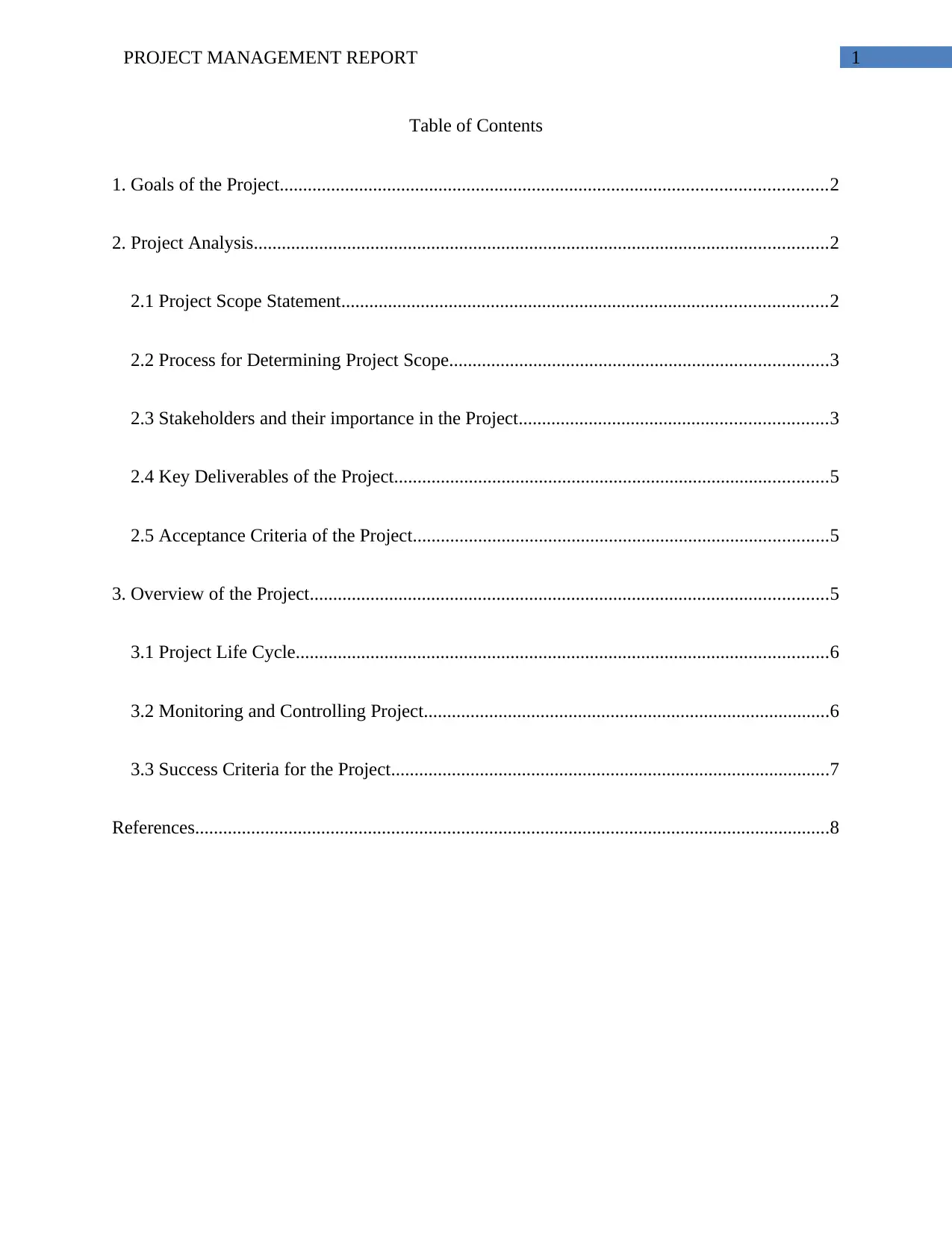
1PROJECT MANAGEMENT REPORT
Table of Contents
1. Goals of the Project.....................................................................................................................2
2. Project Analysis...........................................................................................................................2
2.1 Project Scope Statement........................................................................................................2
2.2 Process for Determining Project Scope.................................................................................3
2.3 Stakeholders and their importance in the Project..................................................................3
2.4 Key Deliverables of the Project.............................................................................................5
2.5 Acceptance Criteria of the Project.........................................................................................5
3. Overview of the Project...............................................................................................................5
3.1 Project Life Cycle..................................................................................................................6
3.2 Monitoring and Controlling Project.......................................................................................6
3.3 Success Criteria for the Project..............................................................................................7
References........................................................................................................................................8
Table of Contents
1. Goals of the Project.....................................................................................................................2
2. Project Analysis...........................................................................................................................2
2.1 Project Scope Statement........................................................................................................2
2.2 Process for Determining Project Scope.................................................................................3
2.3 Stakeholders and their importance in the Project..................................................................3
2.4 Key Deliverables of the Project.............................................................................................5
2.5 Acceptance Criteria of the Project.........................................................................................5
3. Overview of the Project...............................................................................................................5
3.1 Project Life Cycle..................................................................................................................6
3.2 Monitoring and Controlling Project.......................................................................................6
3.3 Success Criteria for the Project..............................................................................................7
References........................................................................................................................................8
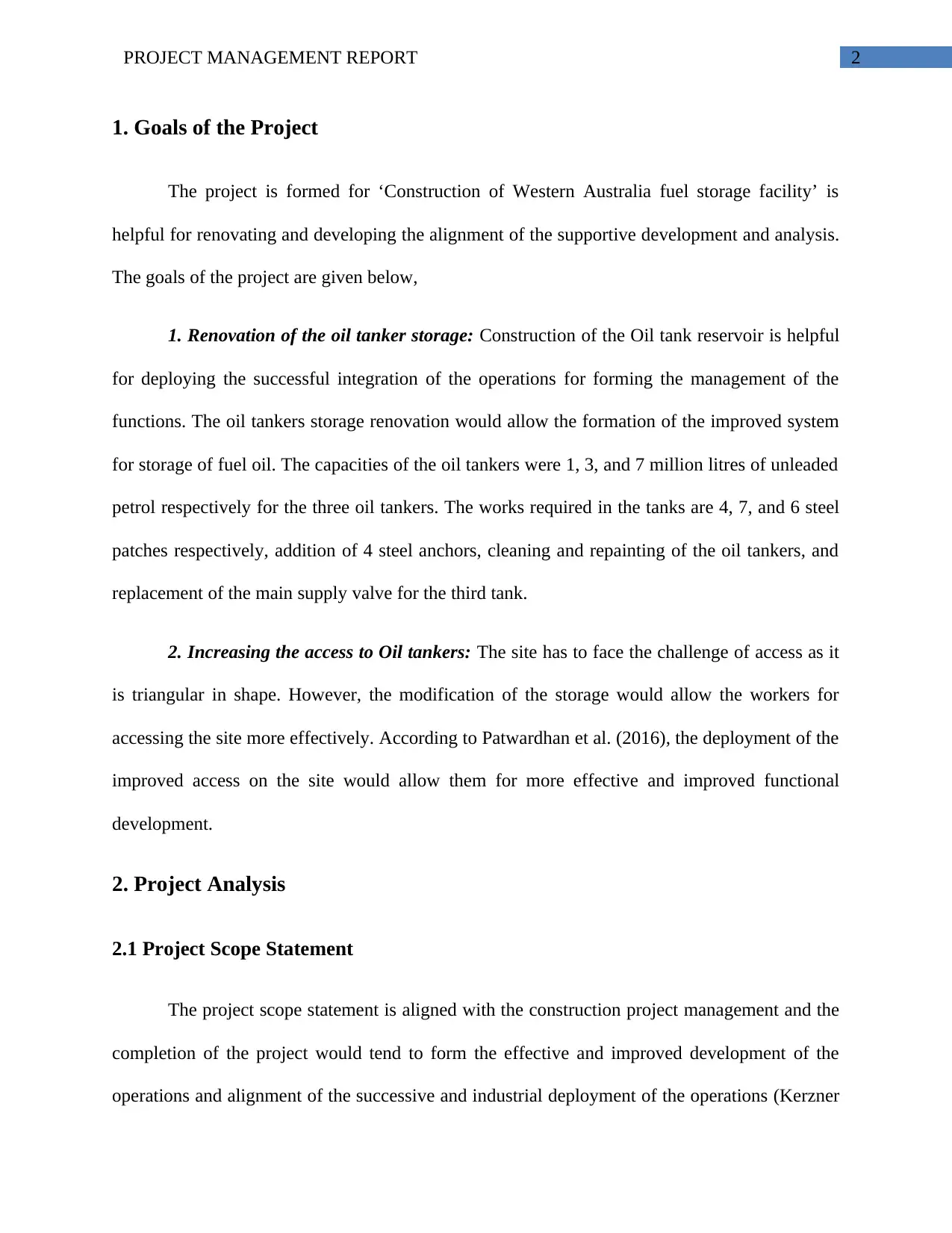
2PROJECT MANAGEMENT REPORT
1. Goals of the Project
The project is formed for ‘Construction of Western Australia fuel storage facility’ is
helpful for renovating and developing the alignment of the supportive development and analysis.
The goals of the project are given below,
1. Renovation of the oil tanker storage: Construction of the Oil tank reservoir is helpful
for deploying the successful integration of the operations for forming the management of the
functions. The oil tankers storage renovation would allow the formation of the improved system
for storage of fuel oil. The capacities of the oil tankers were 1, 3, and 7 million litres of unleaded
petrol respectively for the three oil tankers. The works required in the tanks are 4, 7, and 6 steel
patches respectively, addition of 4 steel anchors, cleaning and repainting of the oil tankers, and
replacement of the main supply valve for the third tank.
2. Increasing the access to Oil tankers: The site has to face the challenge of access as it
is triangular in shape. However, the modification of the storage would allow the workers for
accessing the site more effectively. According to Patwardhan et al. (2016), the deployment of the
improved access on the site would allow them for more effective and improved functional
development.
2. Project Analysis
2.1 Project Scope Statement
The project scope statement is aligned with the construction project management and the
completion of the project would tend to form the effective and improved development of the
operations and alignment of the successive and industrial deployment of the operations (Kerzner
1. Goals of the Project
The project is formed for ‘Construction of Western Australia fuel storage facility’ is
helpful for renovating and developing the alignment of the supportive development and analysis.
The goals of the project are given below,
1. Renovation of the oil tanker storage: Construction of the Oil tank reservoir is helpful
for deploying the successful integration of the operations for forming the management of the
functions. The oil tankers storage renovation would allow the formation of the improved system
for storage of fuel oil. The capacities of the oil tankers were 1, 3, and 7 million litres of unleaded
petrol respectively for the three oil tankers. The works required in the tanks are 4, 7, and 6 steel
patches respectively, addition of 4 steel anchors, cleaning and repainting of the oil tankers, and
replacement of the main supply valve for the third tank.
2. Increasing the access to Oil tankers: The site has to face the challenge of access as it
is triangular in shape. However, the modification of the storage would allow the workers for
accessing the site more effectively. According to Patwardhan et al. (2016), the deployment of the
improved access on the site would allow them for more effective and improved functional
development.
2. Project Analysis
2.1 Project Scope Statement
The project scope statement is aligned with the construction project management and the
completion of the project would tend to form the effective and improved development of the
operations and alignment of the successive and industrial deployment of the operations (Kerzner
⊘ This is a preview!⊘
Do you want full access?
Subscribe today to unlock all pages.

Trusted by 1+ million students worldwide
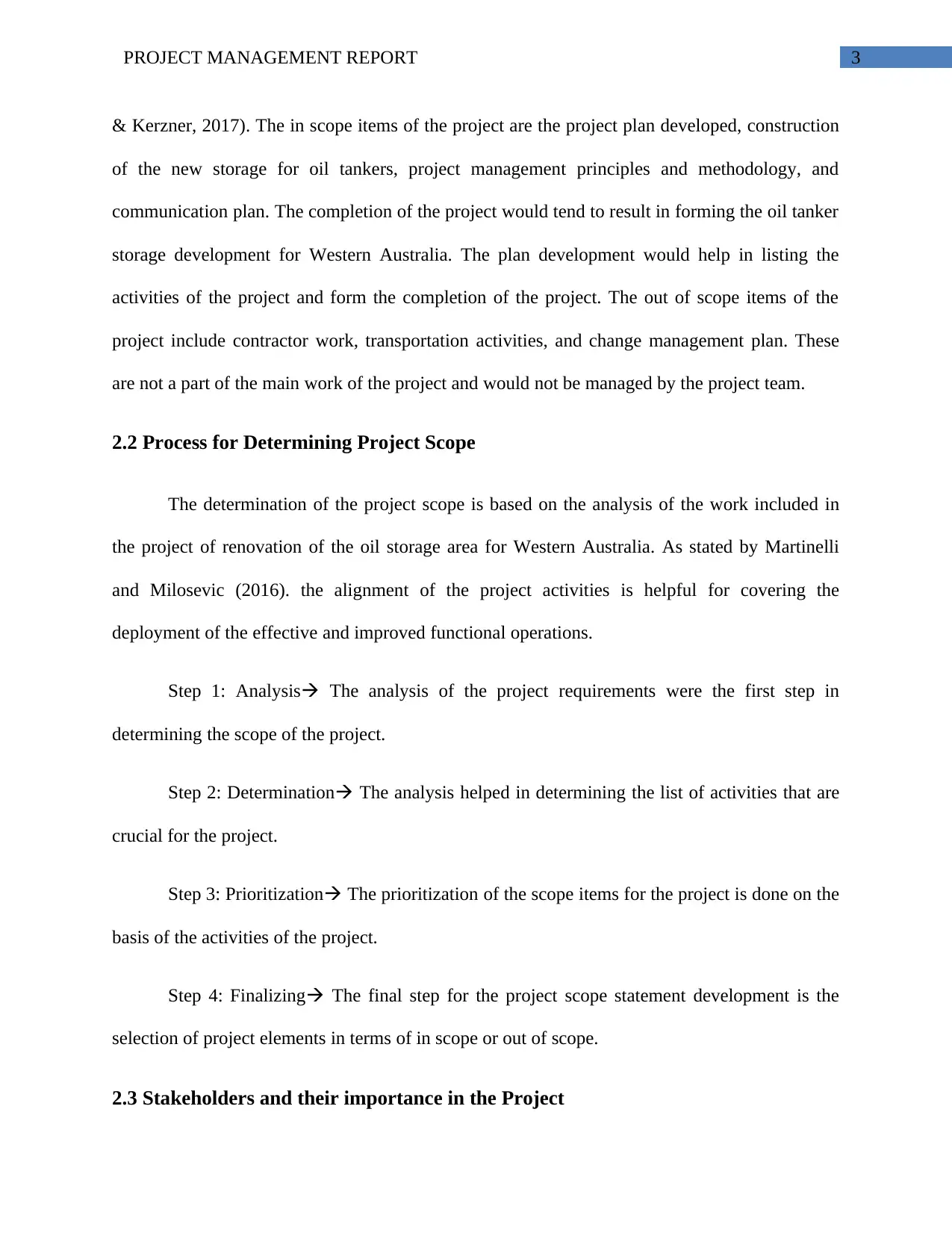
3PROJECT MANAGEMENT REPORT
& Kerzner, 2017). The in scope items of the project are the project plan developed, construction
of the new storage for oil tankers, project management principles and methodology, and
communication plan. The completion of the project would tend to result in forming the oil tanker
storage development for Western Australia. The plan development would help in listing the
activities of the project and form the completion of the project. The out of scope items of the
project include contractor work, transportation activities, and change management plan. These
are not a part of the main work of the project and would not be managed by the project team.
2.2 Process for Determining Project Scope
The determination of the project scope is based on the analysis of the work included in
the project of renovation of the oil storage area for Western Australia. As stated by Martinelli
and Milosevic (2016). the alignment of the project activities is helpful for covering the
deployment of the effective and improved functional operations.
Step 1: Analysis The analysis of the project requirements were the first step in
determining the scope of the project.
Step 2: Determination The analysis helped in determining the list of activities that are
crucial for the project.
Step 3: Prioritization The prioritization of the scope items for the project is done on the
basis of the activities of the project.
Step 4: Finalizing The final step for the project scope statement development is the
selection of project elements in terms of in scope or out of scope.
2.3 Stakeholders and their importance in the Project
& Kerzner, 2017). The in scope items of the project are the project plan developed, construction
of the new storage for oil tankers, project management principles and methodology, and
communication plan. The completion of the project would tend to result in forming the oil tanker
storage development for Western Australia. The plan development would help in listing the
activities of the project and form the completion of the project. The out of scope items of the
project include contractor work, transportation activities, and change management plan. These
are not a part of the main work of the project and would not be managed by the project team.
2.2 Process for Determining Project Scope
The determination of the project scope is based on the analysis of the work included in
the project of renovation of the oil storage area for Western Australia. As stated by Martinelli
and Milosevic (2016). the alignment of the project activities is helpful for covering the
deployment of the effective and improved functional operations.
Step 1: Analysis The analysis of the project requirements were the first step in
determining the scope of the project.
Step 2: Determination The analysis helped in determining the list of activities that are
crucial for the project.
Step 3: Prioritization The prioritization of the scope items for the project is done on the
basis of the activities of the project.
Step 4: Finalizing The final step for the project scope statement development is the
selection of project elements in terms of in scope or out of scope.
2.3 Stakeholders and their importance in the Project
Paraphrase This Document
Need a fresh take? Get an instant paraphrase of this document with our AI Paraphraser
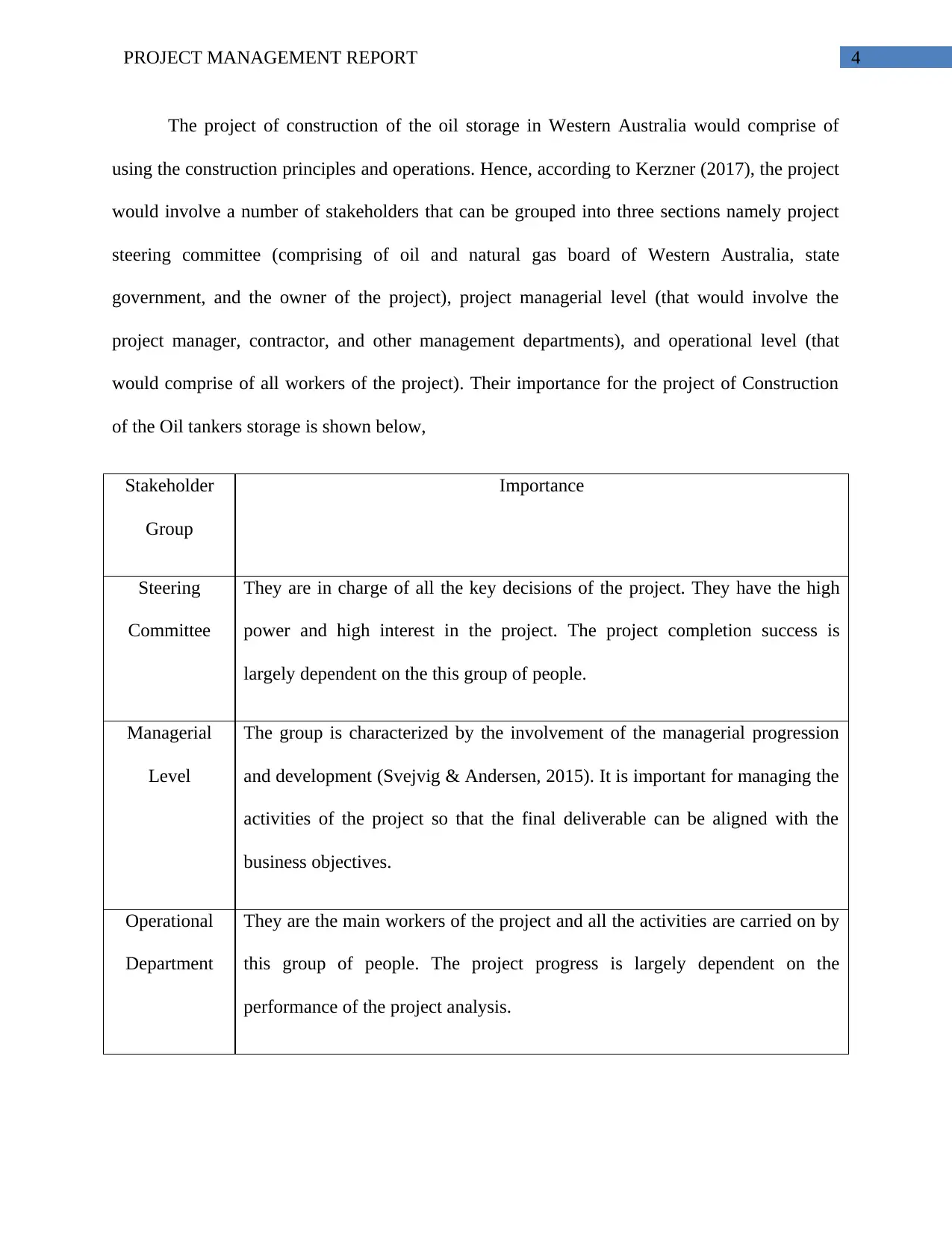
4PROJECT MANAGEMENT REPORT
The project of construction of the oil storage in Western Australia would comprise of
using the construction principles and operations. Hence, according to Kerzner (2017), the project
would involve a number of stakeholders that can be grouped into three sections namely project
steering committee (comprising of oil and natural gas board of Western Australia, state
government, and the owner of the project), project managerial level (that would involve the
project manager, contractor, and other management departments), and operational level (that
would comprise of all workers of the project). Their importance for the project of Construction
of the Oil tankers storage is shown below,
Stakeholder
Group
Importance
Steering
Committee
They are in charge of all the key decisions of the project. They have the high
power and high interest in the project. The project completion success is
largely dependent on the this group of people.
Managerial
Level
The group is characterized by the involvement of the managerial progression
and development (Svejvig & Andersen, 2015). It is important for managing the
activities of the project so that the final deliverable can be aligned with the
business objectives.
Operational
Department
They are the main workers of the project and all the activities are carried on by
this group of people. The project progress is largely dependent on the
performance of the project analysis.
The project of construction of the oil storage in Western Australia would comprise of
using the construction principles and operations. Hence, according to Kerzner (2017), the project
would involve a number of stakeholders that can be grouped into three sections namely project
steering committee (comprising of oil and natural gas board of Western Australia, state
government, and the owner of the project), project managerial level (that would involve the
project manager, contractor, and other management departments), and operational level (that
would comprise of all workers of the project). Their importance for the project of Construction
of the Oil tankers storage is shown below,
Stakeholder
Group
Importance
Steering
Committee
They are in charge of all the key decisions of the project. They have the high
power and high interest in the project. The project completion success is
largely dependent on the this group of people.
Managerial
Level
The group is characterized by the involvement of the managerial progression
and development (Svejvig & Andersen, 2015). It is important for managing the
activities of the project so that the final deliverable can be aligned with the
business objectives.
Operational
Department
They are the main workers of the project and all the activities are carried on by
this group of people. The project progress is largely dependent on the
performance of the project analysis.
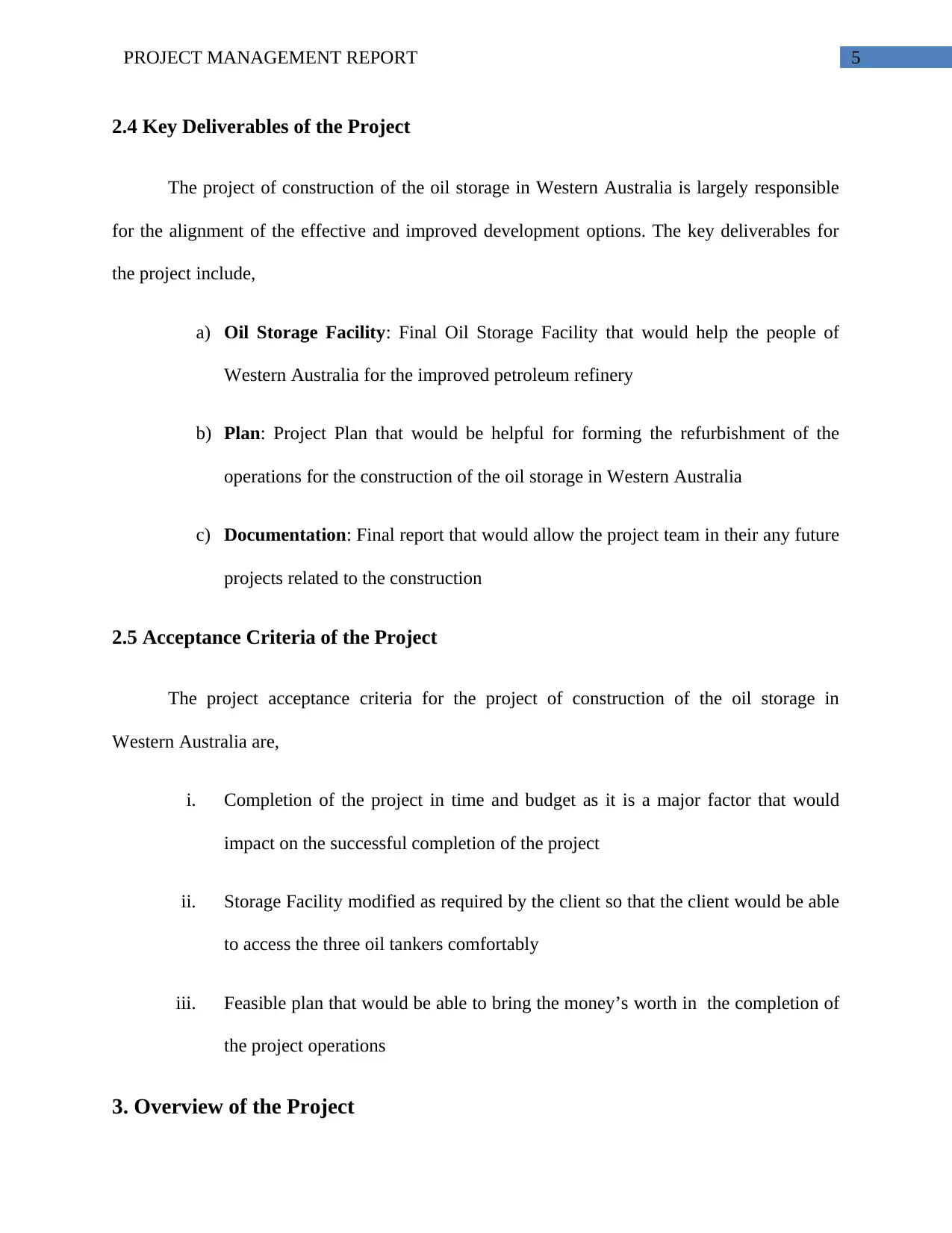
5PROJECT MANAGEMENT REPORT
2.4 Key Deliverables of the Project
The project of construction of the oil storage in Western Australia is largely responsible
for the alignment of the effective and improved development options. The key deliverables for
the project include,
a) Oil Storage Facility: Final Oil Storage Facility that would help the people of
Western Australia for the improved petroleum refinery
b) Plan: Project Plan that would be helpful for forming the refurbishment of the
operations for the construction of the oil storage in Western Australia
c) Documentation: Final report that would allow the project team in their any future
projects related to the construction
2.5 Acceptance Criteria of the Project
The project acceptance criteria for the project of construction of the oil storage in
Western Australia are,
i. Completion of the project in time and budget as it is a major factor that would
impact on the successful completion of the project
ii. Storage Facility modified as required by the client so that the client would be able
to access the three oil tankers comfortably
iii. Feasible plan that would be able to bring the money’s worth in the completion of
the project operations
3. Overview of the Project
2.4 Key Deliverables of the Project
The project of construction of the oil storage in Western Australia is largely responsible
for the alignment of the effective and improved development options. The key deliverables for
the project include,
a) Oil Storage Facility: Final Oil Storage Facility that would help the people of
Western Australia for the improved petroleum refinery
b) Plan: Project Plan that would be helpful for forming the refurbishment of the
operations for the construction of the oil storage in Western Australia
c) Documentation: Final report that would allow the project team in their any future
projects related to the construction
2.5 Acceptance Criteria of the Project
The project acceptance criteria for the project of construction of the oil storage in
Western Australia are,
i. Completion of the project in time and budget as it is a major factor that would
impact on the successful completion of the project
ii. Storage Facility modified as required by the client so that the client would be able
to access the three oil tankers comfortably
iii. Feasible plan that would be able to bring the money’s worth in the completion of
the project operations
3. Overview of the Project
⊘ This is a preview!⊘
Do you want full access?
Subscribe today to unlock all pages.

Trusted by 1+ million students worldwide
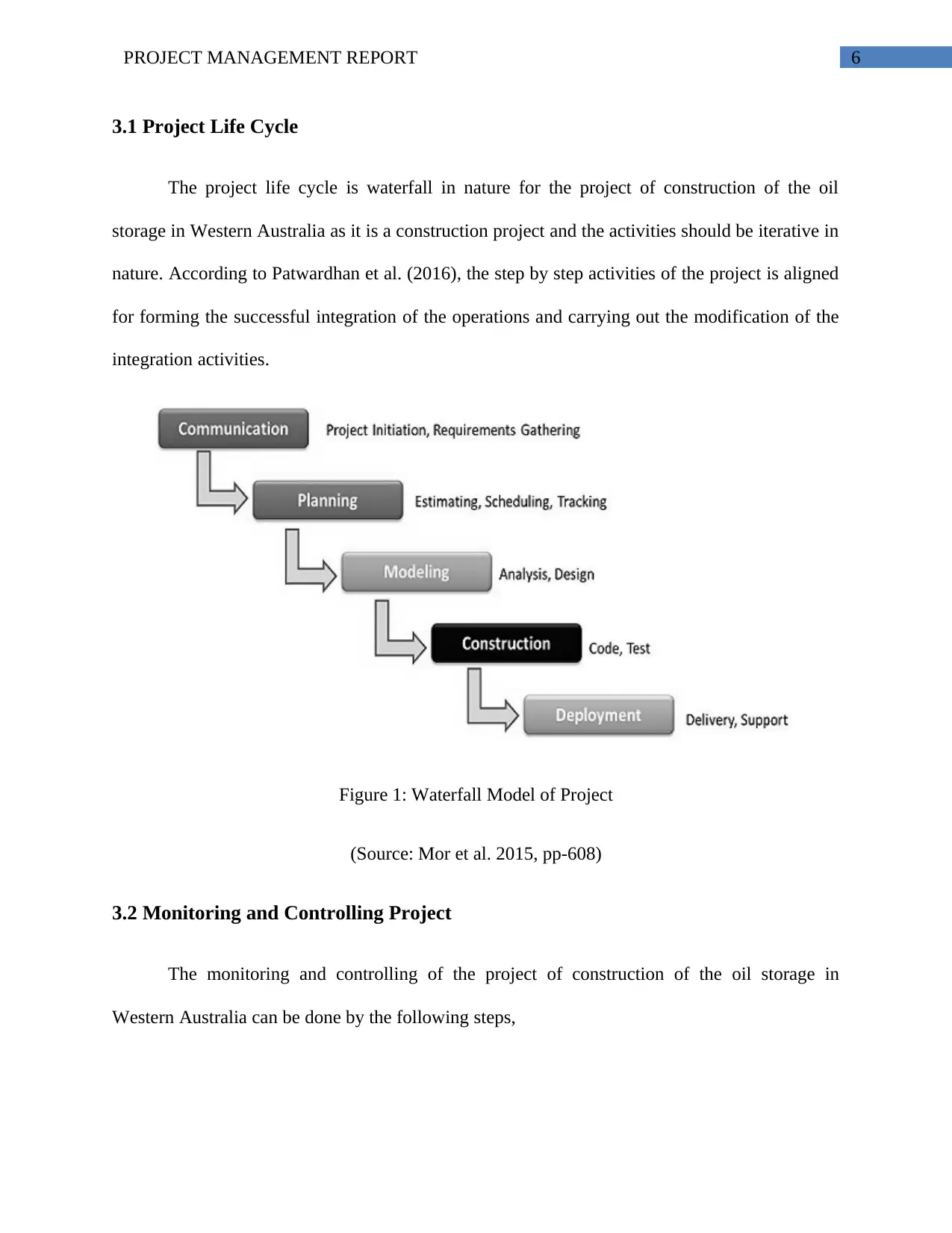
6PROJECT MANAGEMENT REPORT
3.1 Project Life Cycle
The project life cycle is waterfall in nature for the project of construction of the oil
storage in Western Australia as it is a construction project and the activities should be iterative in
nature. According to Patwardhan et al. (2016), the step by step activities of the project is aligned
for forming the successful integration of the operations and carrying out the modification of the
integration activities.
Figure 1: Waterfall Model of Project
(Source: Mor et al. 2015, pp-608)
3.2 Monitoring and Controlling Project
The monitoring and controlling of the project of construction of the oil storage in
Western Australia can be done by the following steps,
3.1 Project Life Cycle
The project life cycle is waterfall in nature for the project of construction of the oil
storage in Western Australia as it is a construction project and the activities should be iterative in
nature. According to Patwardhan et al. (2016), the step by step activities of the project is aligned
for forming the successful integration of the operations and carrying out the modification of the
integration activities.
Figure 1: Waterfall Model of Project
(Source: Mor et al. 2015, pp-608)
3.2 Monitoring and Controlling Project
The monitoring and controlling of the project of construction of the oil storage in
Western Australia can be done by the following steps,
Paraphrase This Document
Need a fresh take? Get an instant paraphrase of this document with our AI Paraphraser
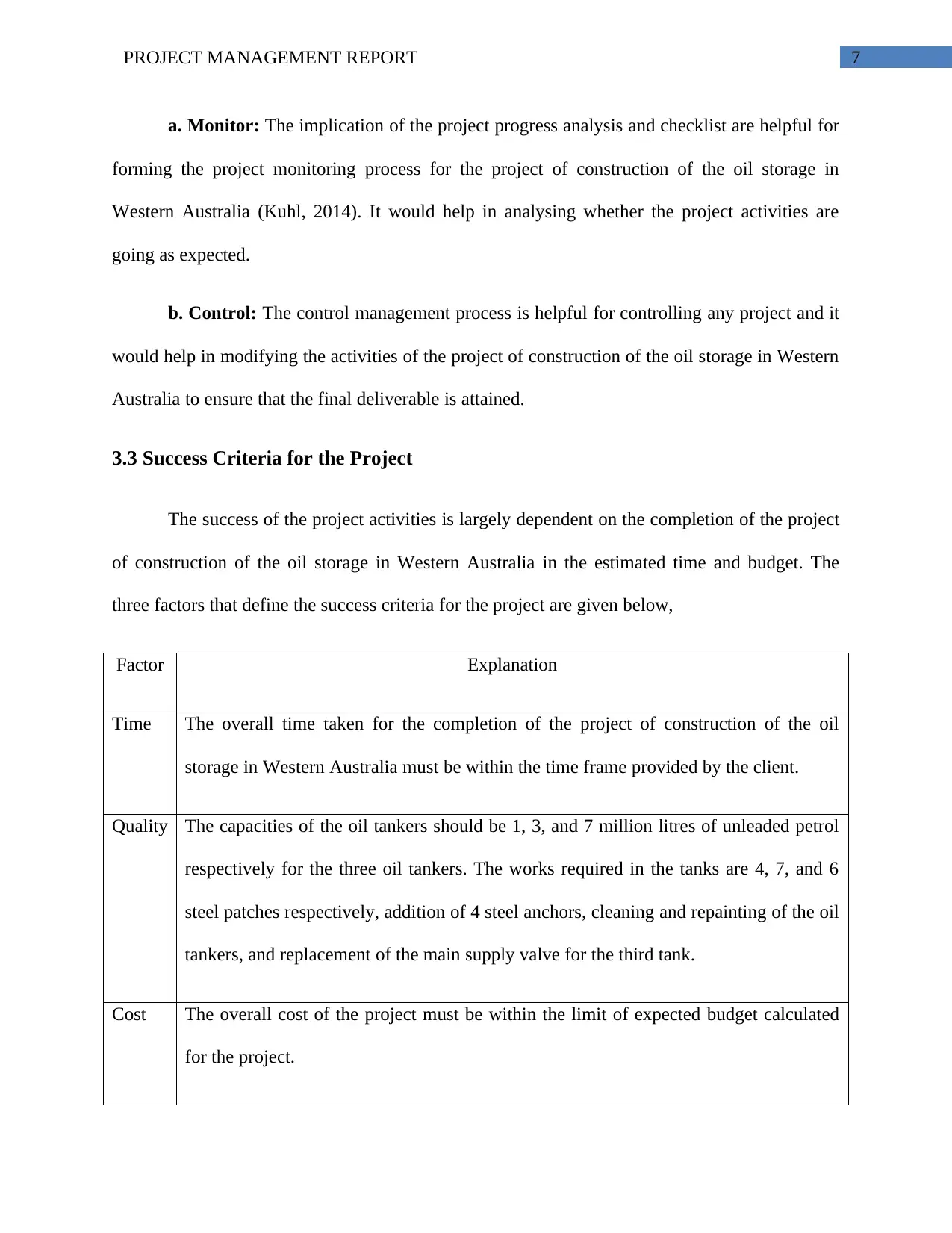
7PROJECT MANAGEMENT REPORT
a. Monitor: The implication of the project progress analysis and checklist are helpful for
forming the project monitoring process for the project of construction of the oil storage in
Western Australia (Kuhl, 2014). It would help in analysing whether the project activities are
going as expected.
b. Control: The control management process is helpful for controlling any project and it
would help in modifying the activities of the project of construction of the oil storage in Western
Australia to ensure that the final deliverable is attained.
3.3 Success Criteria for the Project
The success of the project activities is largely dependent on the completion of the project
of construction of the oil storage in Western Australia in the estimated time and budget. The
three factors that define the success criteria for the project are given below,
Factor Explanation
Time The overall time taken for the completion of the project of construction of the oil
storage in Western Australia must be within the time frame provided by the client.
Quality The capacities of the oil tankers should be 1, 3, and 7 million litres of unleaded petrol
respectively for the three oil tankers. The works required in the tanks are 4, 7, and 6
steel patches respectively, addition of 4 steel anchors, cleaning and repainting of the oil
tankers, and replacement of the main supply valve for the third tank.
Cost The overall cost of the project must be within the limit of expected budget calculated
for the project.
a. Monitor: The implication of the project progress analysis and checklist are helpful for
forming the project monitoring process for the project of construction of the oil storage in
Western Australia (Kuhl, 2014). It would help in analysing whether the project activities are
going as expected.
b. Control: The control management process is helpful for controlling any project and it
would help in modifying the activities of the project of construction of the oil storage in Western
Australia to ensure that the final deliverable is attained.
3.3 Success Criteria for the Project
The success of the project activities is largely dependent on the completion of the project
of construction of the oil storage in Western Australia in the estimated time and budget. The
three factors that define the success criteria for the project are given below,
Factor Explanation
Time The overall time taken for the completion of the project of construction of the oil
storage in Western Australia must be within the time frame provided by the client.
Quality The capacities of the oil tankers should be 1, 3, and 7 million litres of unleaded petrol
respectively for the three oil tankers. The works required in the tanks are 4, 7, and 6
steel patches respectively, addition of 4 steel anchors, cleaning and repainting of the oil
tankers, and replacement of the main supply valve for the third tank.
Cost The overall cost of the project must be within the limit of expected budget calculated
for the project.
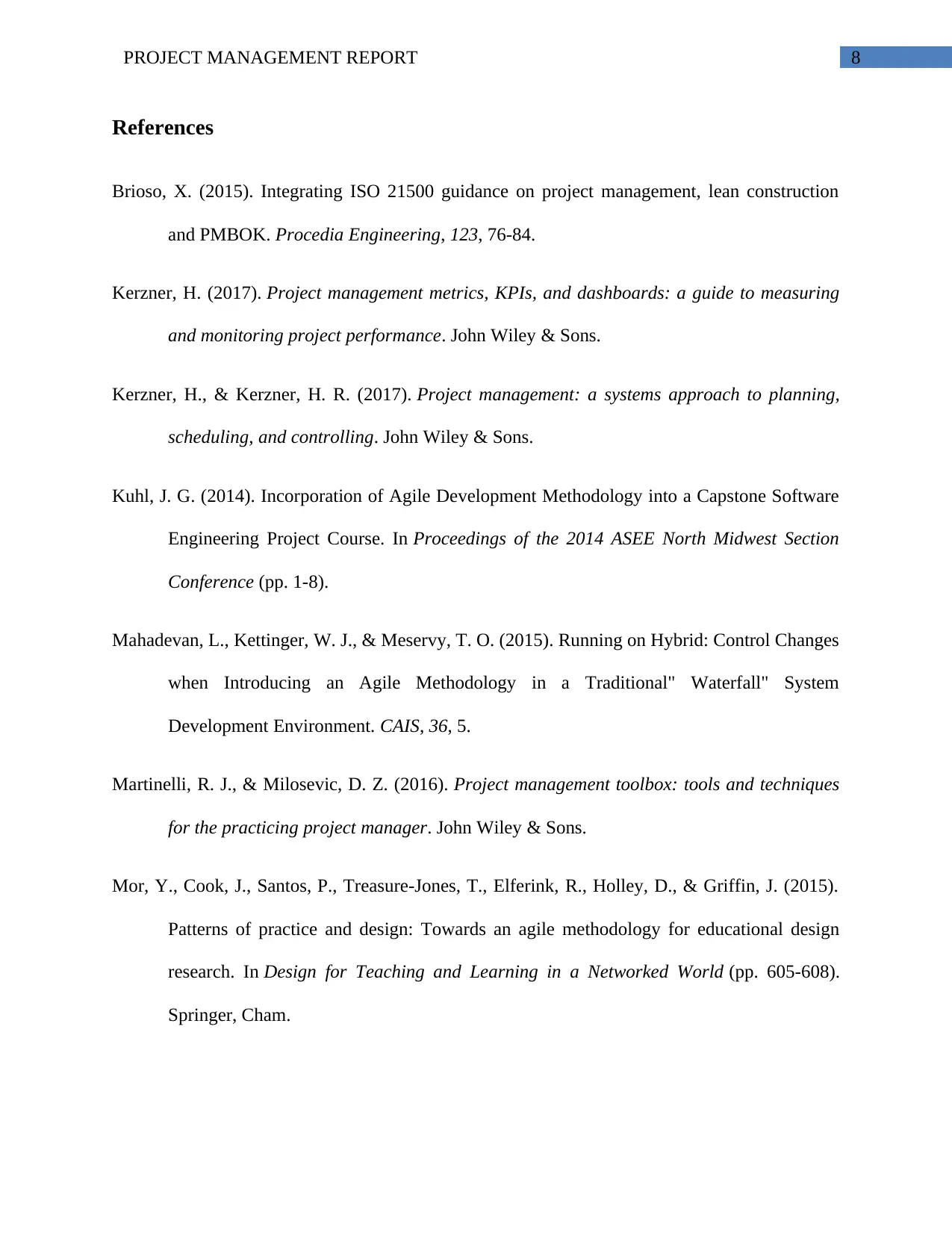
8PROJECT MANAGEMENT REPORT
References
Brioso, X. (2015). Integrating ISO 21500 guidance on project management, lean construction
and PMBOK. Procedia Engineering, 123, 76-84.
Kerzner, H. (2017). Project management metrics, KPIs, and dashboards: a guide to measuring
and monitoring project performance. John Wiley & Sons.
Kerzner, H., & Kerzner, H. R. (2017). Project management: a systems approach to planning,
scheduling, and controlling. John Wiley & Sons.
Kuhl, J. G. (2014). Incorporation of Agile Development Methodology into a Capstone Software
Engineering Project Course. In Proceedings of the 2014 ASEE North Midwest Section
Conference (pp. 1-8).
Mahadevan, L., Kettinger, W. J., & Meservy, T. O. (2015). Running on Hybrid: Control Changes
when Introducing an Agile Methodology in a Traditional" Waterfall" System
Development Environment. CAIS, 36, 5.
Martinelli, R. J., & Milosevic, D. Z. (2016). Project management toolbox: tools and techniques
for the practicing project manager. John Wiley & Sons.
Mor, Y., Cook, J., Santos, P., Treasure-Jones, T., Elferink, R., Holley, D., & Griffin, J. (2015).
Patterns of practice and design: Towards an agile methodology for educational design
research. In Design for Teaching and Learning in a Networked World (pp. 605-608).
Springer, Cham.
References
Brioso, X. (2015). Integrating ISO 21500 guidance on project management, lean construction
and PMBOK. Procedia Engineering, 123, 76-84.
Kerzner, H. (2017). Project management metrics, KPIs, and dashboards: a guide to measuring
and monitoring project performance. John Wiley & Sons.
Kerzner, H., & Kerzner, H. R. (2017). Project management: a systems approach to planning,
scheduling, and controlling. John Wiley & Sons.
Kuhl, J. G. (2014). Incorporation of Agile Development Methodology into a Capstone Software
Engineering Project Course. In Proceedings of the 2014 ASEE North Midwest Section
Conference (pp. 1-8).
Mahadevan, L., Kettinger, W. J., & Meservy, T. O. (2015). Running on Hybrid: Control Changes
when Introducing an Agile Methodology in a Traditional" Waterfall" System
Development Environment. CAIS, 36, 5.
Martinelli, R. J., & Milosevic, D. Z. (2016). Project management toolbox: tools and techniques
for the practicing project manager. John Wiley & Sons.
Mor, Y., Cook, J., Santos, P., Treasure-Jones, T., Elferink, R., Holley, D., & Griffin, J. (2015).
Patterns of practice and design: Towards an agile methodology for educational design
research. In Design for Teaching and Learning in a Networked World (pp. 605-608).
Springer, Cham.
⊘ This is a preview!⊘
Do you want full access?
Subscribe today to unlock all pages.

Trusted by 1+ million students worldwide
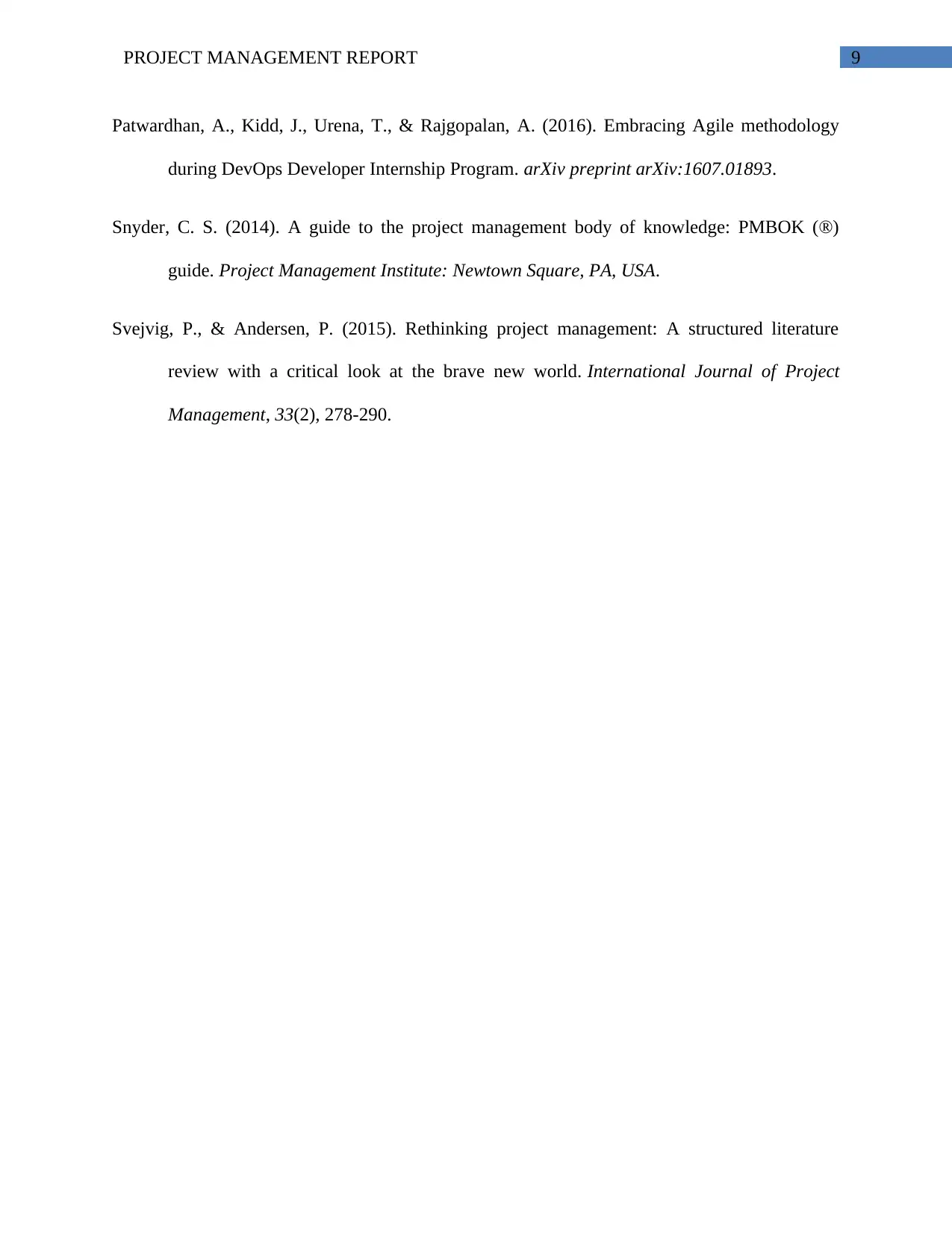
9PROJECT MANAGEMENT REPORT
Patwardhan, A., Kidd, J., Urena, T., & Rajgopalan, A. (2016). Embracing Agile methodology
during DevOps Developer Internship Program. arXiv preprint arXiv:1607.01893.
Snyder, C. S. (2014). A guide to the project management body of knowledge: PMBOK (®)
guide. Project Management Institute: Newtown Square, PA, USA.
Svejvig, P., & Andersen, P. (2015). Rethinking project management: A structured literature
review with a critical look at the brave new world. International Journal of Project
Management, 33(2), 278-290.
Patwardhan, A., Kidd, J., Urena, T., & Rajgopalan, A. (2016). Embracing Agile methodology
during DevOps Developer Internship Program. arXiv preprint arXiv:1607.01893.
Snyder, C. S. (2014). A guide to the project management body of knowledge: PMBOK (®)
guide. Project Management Institute: Newtown Square, PA, USA.
Svejvig, P., & Andersen, P. (2015). Rethinking project management: A structured literature
review with a critical look at the brave new world. International Journal of Project
Management, 33(2), 278-290.
1 out of 10
Related Documents
Your All-in-One AI-Powered Toolkit for Academic Success.
+13062052269
info@desklib.com
Available 24*7 on WhatsApp / Email
![[object Object]](/_next/static/media/star-bottom.7253800d.svg)
Unlock your academic potential
Copyright © 2020–2025 A2Z Services. All Rights Reserved. Developed and managed by ZUCOL.





